Data Dive – East Side Elementary
Data Dive – East Side Elementary
Throughout the school year, students at each school in Haywood County Schools are assessed three times in order to gauge where each individual student is on their personal learning journey. These assessments allow teachers to monitor student learning progress while also gaining insight into what specific areas of a subject a student could use extra support.
While teachers, schools, and districts are measured mostly on TNReady data, the benchmark assessments given throughout the year provide a more accurate view at the learning taking place in the classroom. The assessments used to measure learning in each school in HCS are the AimsWeb assessments in Reading and Math and the IReady assessments in the same subjects. The AimsWeb assessment is given in Kindergarten through Tenth Grades. The IReady assessment is given in grades K-8.
The AimsWeb assessments in Reading and Math measure basic skills in each subject. Basic skills include reading comprehension and fluency and making calculations of measurements, sizes, and amounts. AimsWeb is an assessment that is used to monitor progress and ensure the majority of our students at each grade level are working toward basic grade level skills in each subject.
The IReady assessment measures student progress in relation to state academic standards. This assessment is not always reflective of the basic skills of students in Reading and Math, but shows how well students understand the standards being taught. State standards are created in order to push the students to think at a deeper level beyond the basic skill levels of a subject. These tests combine test taking skills with in-depth knowledge of each subject. This assessment is more closely aligned with the year-end TNReady standardized tests given each spring.
Over the next two weeks, HCS will be sharing grade level data from each school that shows the results from AimsWeb, IReady, and the TNReady assessments. The TNReady assessment is given in grades 2-8.
At the beginning of the year, each school sets a goal based on the fall benchmark. In the horizontal graphs below, results from the fall, winter, and spring benchmark assessments will be shown and compared with the goals set from each school
East Side Elementary is made up of third and fourth grade students. In a lot of ways, this past school year was a lot like attending school for the first time on a full time basis. Like every school in HCS, East Side showed learning and growth throughout the school year on the AimsWeb and IReady assessments.
AimsWeb – Third and Fourth Grade
AimsWeb uses a three tiered system to measure student progress and provide information regarding where students are on their learning paths. While we want all students to be in Tier 1, a more realistic goal (especially coming on the heels of two fractured years of in-person learning) is to see substantial growth in our collective group of Tier 1 students. The tiers are described below:
Tier 1 = Low Risk (about 75%–95% of students in this group will meet the target): Students are on track to meet the end-of-year target and are least likely to need intervention. These students should continue to receive the general instructional program. Typically, the majority of students fall into this category.
Tier 2 = Moderate Risk (about 25%–65% of students in this group will not meet the target): Students are not on track and have a moderate risk of not meeting the end-of-year target. These students require some type of intervention, often taking the form of supplemental small group instruction.
Tier 3 = High Risk (about 50%–90% of students in this group will not meet the target): Students are not on track and are typically well-below grade level. These students have a high risk of not meeting the end-of-year target without intensive, individualized instructional intervention.
 At the beginning of the year, almost half of ESE third grade students found themselves in Tier 3 after the first Aimsweb assessment. By the end of the year, only 25% of third grade students were in Tier 3.
At the beginning of the year, almost half of ESE third grade students found themselves in Tier 3 after the first Aimsweb assessment. By the end of the year, only 25% of third grade students were in Tier 3.
ESE had a goal of having 107 students in Tier 1 reading in third grade. They met their goal and even exceeded it by 1. They increased their number of Tier 1 students in third grade reading by 25 and finished the year with 55% of third grade students on or above grade level in reading.
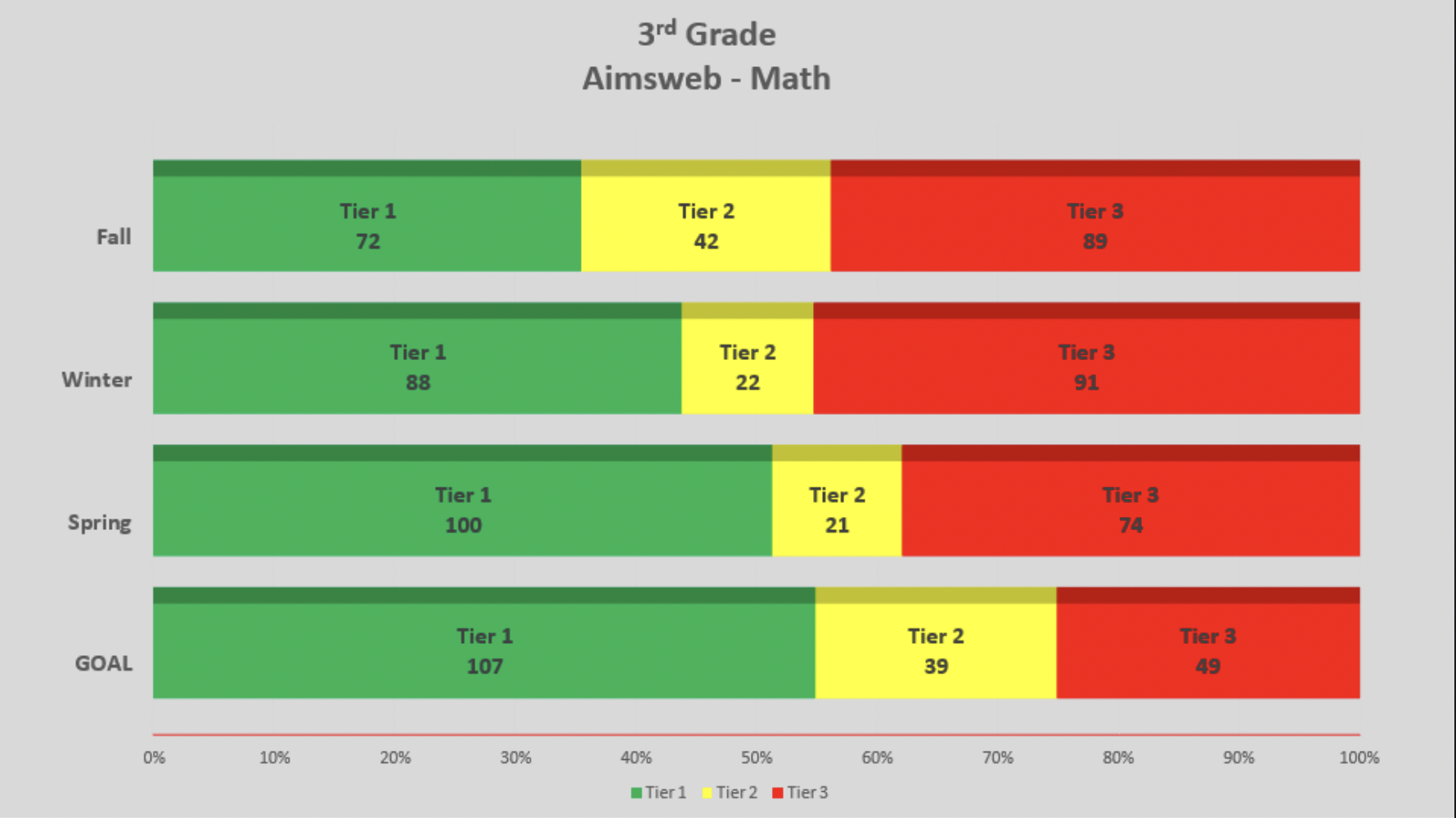 Third grade students at ESE in Tier 1 Math increased by nearly 30 students and made up over half the grade by the end of the year.
Third grade students at ESE in Tier 1 Math increased by nearly 30 students and made up over half the grade by the end of the year.
Tier 3 students in third grade math didn’t show as much growth as anticipated, however. At the beginning of the year, there were 89 students in Tier 3 and, at the end of the year, there were 74 students still in Tier 3.

Fourth grade students showed significant learning growth throughout the year in reading… Tier 1 students increased by 43 from the fall to the spring. A total of 113 fourth grade students found themselves in Tier 1 at the end of the year surpassing the goal of 109 set at the beginning of the year.
A total of 28 students moved out of Tier 3 and moved closer to being on or above grade level in reading.
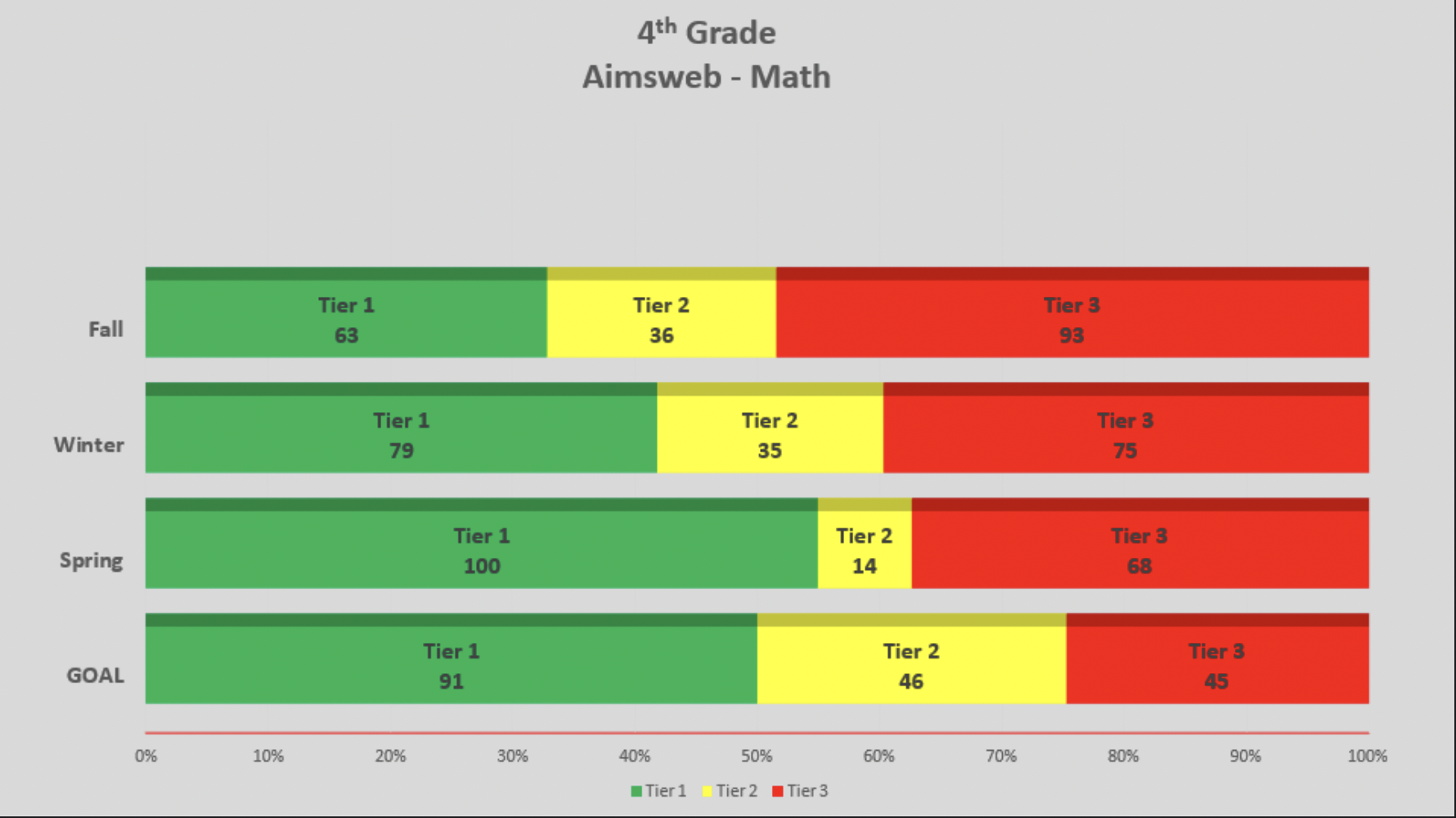
Fourth grade math students at ESE exceeded the goal of Tier 1 students by moving a total 32 students into Tier 1 from the fall to the spring. A total of 100 students were in Tier 1 math by the end of the year and exceeded the goal of 91 that was set in the fall.
Tier 3 students shrank by 23, but still made up just under 40% of the grade.
IReady Data – Third and Fourth Grade
IReady data is broken down into five sub-groups and is an assessment that compares well with the TNReady assessment based on the style of questions that are asked. Here is how the scoring is broken down:
- Mid/Above grade level: this group is made up of students who are proficient or mastering the grade level educational standards being taught.
- Early on grade level: this group is made up of students who are on track to mastery or proficiency of the grade level subject being taught.
- 1 grade below: this group of students is one grade behind their current grade level as it pertains to the standard being taught.
- 2 grades below: this group of students is two grades behind their current grade level as it pertains to the standard being taught.
- 3 grades below: this group of students is three grades or more behind their current grade level as it pertains to the standard being taught.
As previously stated, the Iready assessment measures how well students are learning the standards being taught in the classroom. This assessment goes beyond basic skill levels in certain subjects and measures student learning in similar ways as the TNReady assessment.
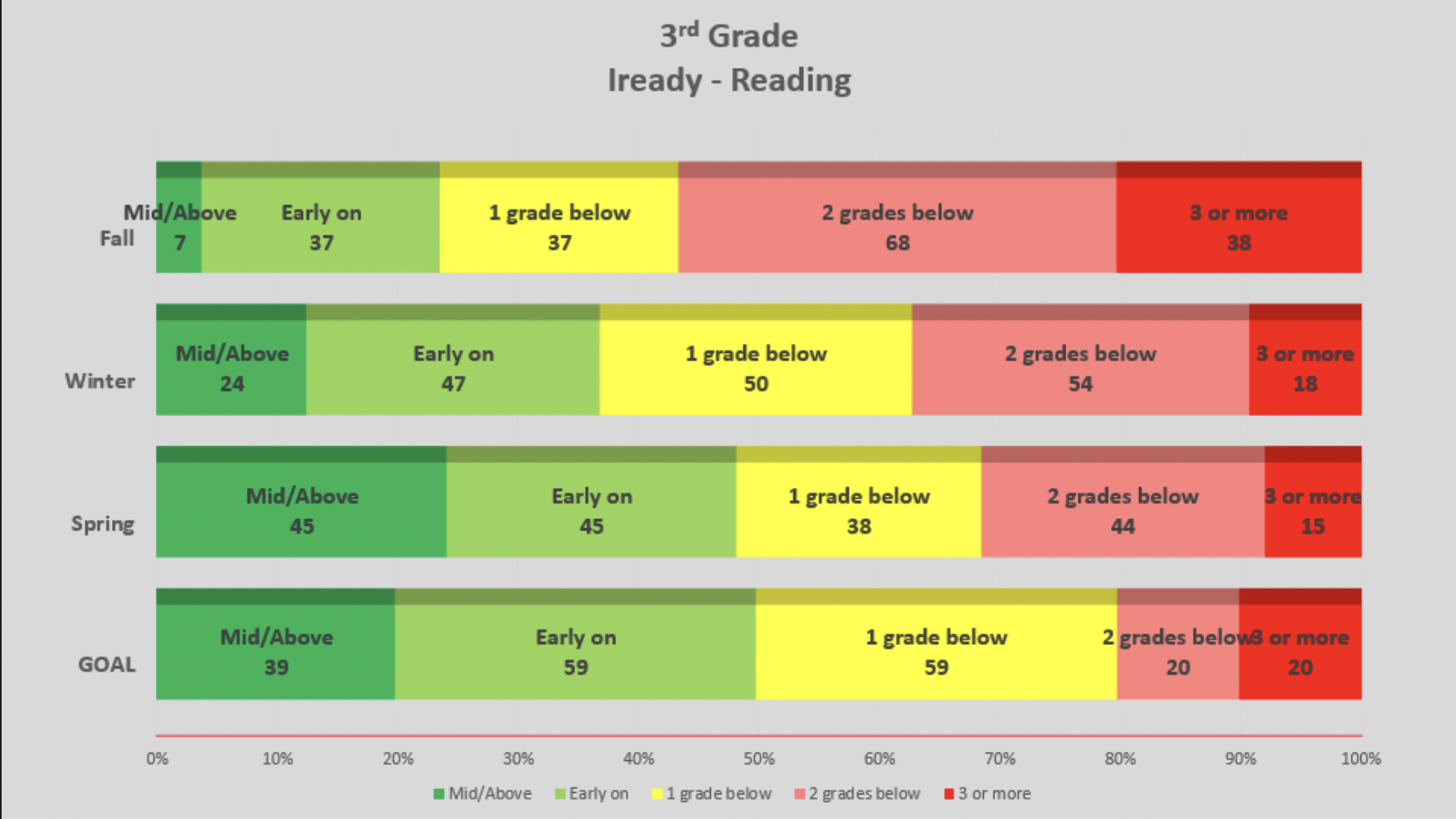 At the beginning of the year, only 44 third grade students at ESE were on or above grade level in reading. By the end of the year, that number had essentially doubled to 90 students being on or above grade level. The grade moved from 25% proficiency to 50% proficiency from fall to spring.
At the beginning of the year, only 44 third grade students at ESE were on or above grade level in reading. By the end of the year, that number had essentially doubled to 90 students being on or above grade level. The grade moved from 25% proficiency to 50% proficiency from fall to spring.
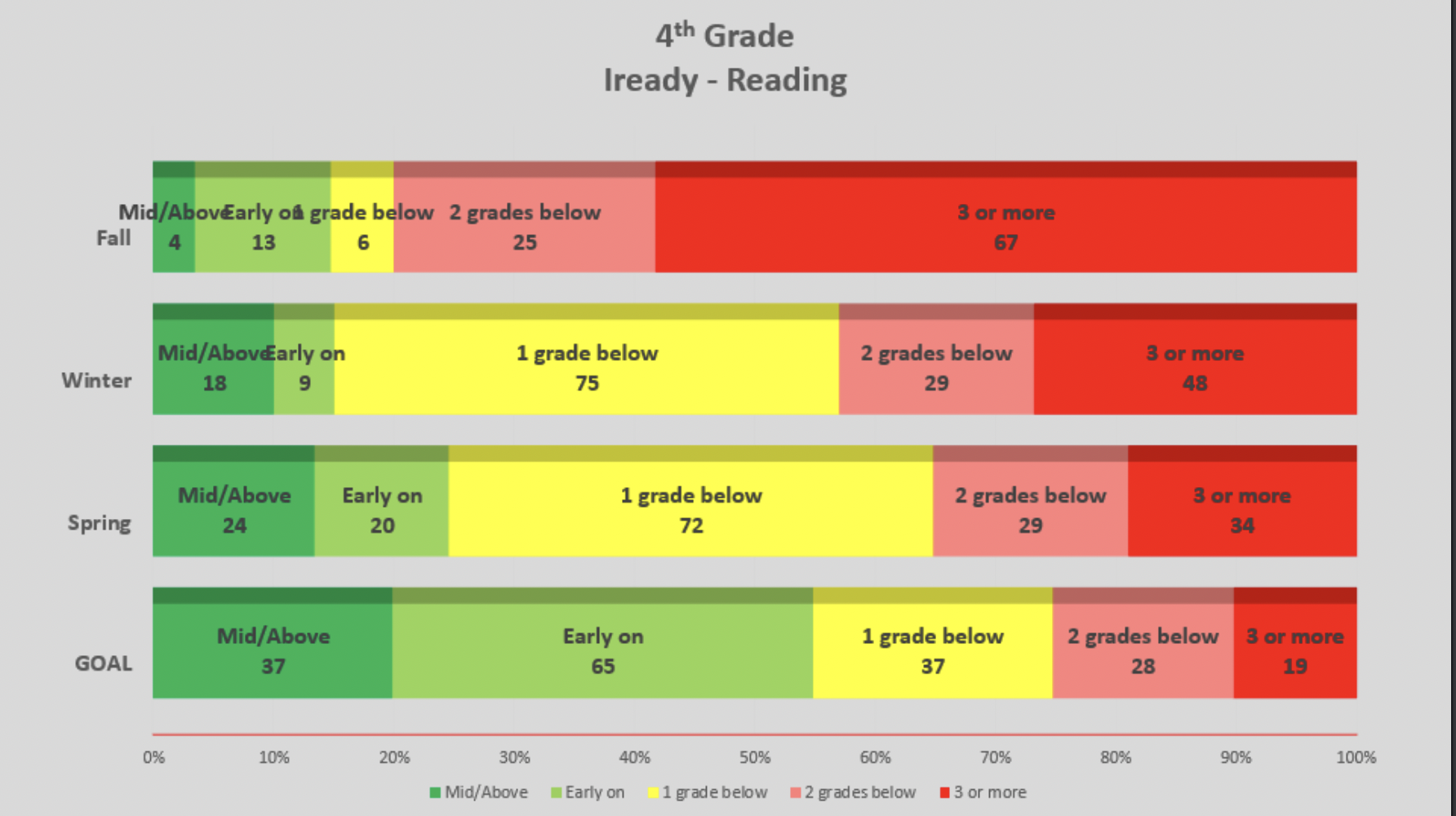 On the surface of 4th grade IReady reading data, there doesn’t look like there’s much to celebrate as far as on or above grade level reading is concerned. However, as with all data, sometimes the most encouraging aspect of it is what lies just under the surface.
On the surface of 4th grade IReady reading data, there doesn’t look like there’s much to celebrate as far as on or above grade level reading is concerned. However, as with all data, sometimes the most encouraging aspect of it is what lies just under the surface.
At the beginning of the year, the number of 4th grade students who were two or more grades below grade level in reading totaled 92 – that’s nearly 80% of the grade level. By the end of the year, however, only 63 students fell into this category. More importantly, the number of students who were three or more grade levels behind was cut in half from 67 to 34. The percentage of fourth grade students who were two or more grade levels behind in reading fell from 80% to 35%.
Fourth grade students who were on or above grade level rose from 17 to 44 by the end of the year.
Moving students in early elementary school who are multiple grade levels behind in a subject to only being one grade below is vital to educational success as students move toward middle school. East Side did their part in moving their fourth grade students forward.
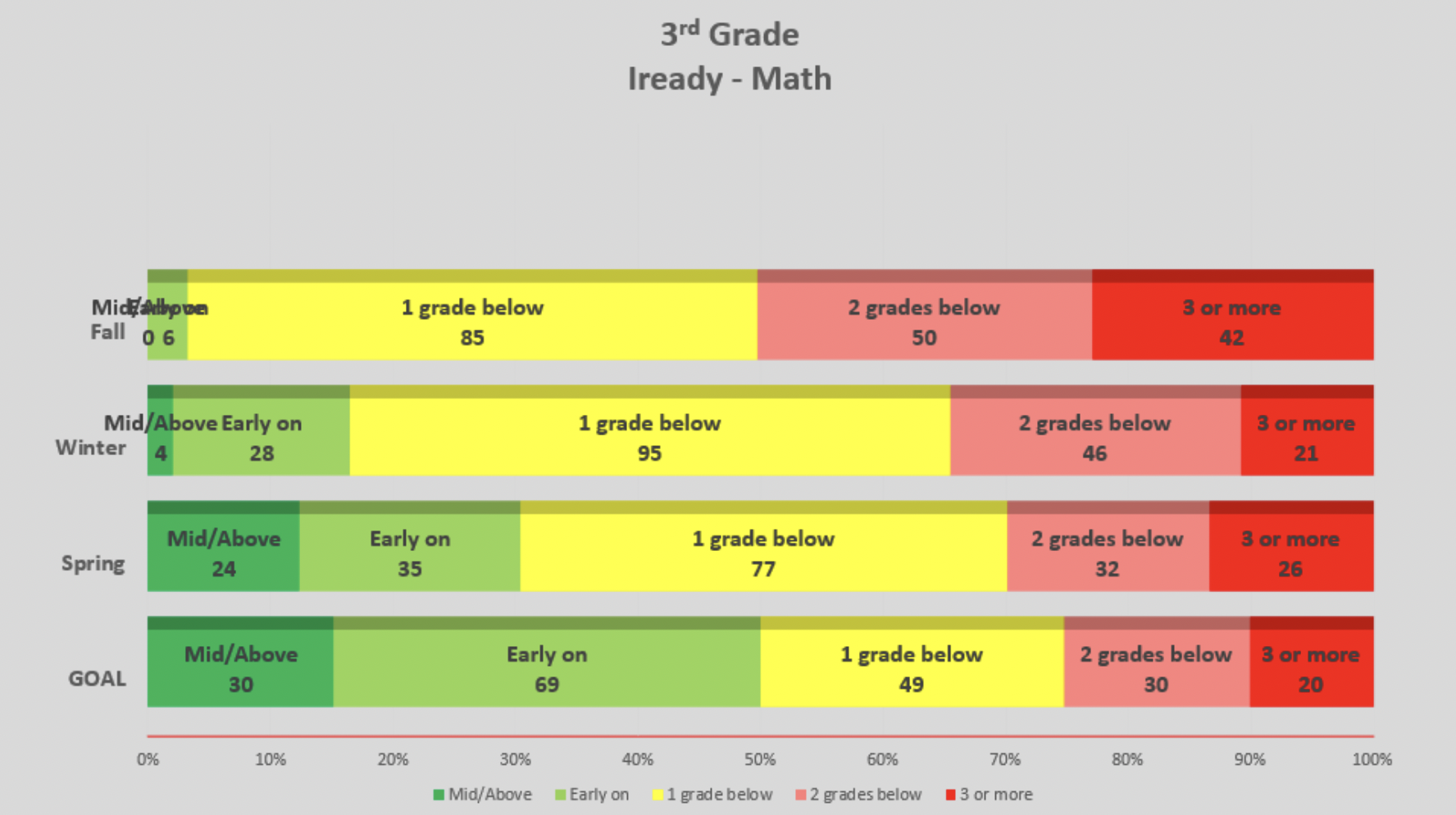
Third grade students made big gains in grade level or above metrics on the math IReady. On the fall assessment, only six students were on or above grade level in third grade math standards. By the end of the spring semester, 59 students were on or above grade level in third grade math on IReady math. That is a substantial gain over the course of a year.
 Much like third grade, fourth grade saw tremendous jumps in their number of students who were on or above grade level in math on the IReady assessment.
Much like third grade, fourth grade saw tremendous jumps in their number of students who were on or above grade level in math on the IReady assessment.
After the fall test, only nine students were on or above grade level in math. After the spring assessment, however, 42 students were on or above grade level. While East Side’s goal of 74 students being on or above grade level on the fourth grade IReady math assessment wasn’t met, the progress made was still promising.
TNReady TCAP Data
3rd Grade

ELA
*Third grade students at East Side made gains higher than the state average in ELA.
51 third grade students met or exceeded grade level expectations in ELA and that made up nearly 30% of the class.
Math
26 third grade students met or exceeded grade level expectations in Math with 64 students approaching grade level expectations.
111 third grade students were below grade level expectations on the standardized test.
Science
59 third grade students met or exceeded grade level expectations in science with 84 students approaching grade level expectations.
Only 53 students were below grade level expectations in Science.
4th Grade TNReady TCAP Data

ELA
28 students met or exceeded grade level expectations in ELA with 77 students approaching grade level mastery.
Math
15 students met or exceeded grade level expectations in fourth grade Math.
Science
58 students met or exceeded grade level expectations in fourth grade Science with 67 students approaching grade level expectations. Only 30% of students were below grade level based on the standardized test data.
While data never tells the entire story of learning within a school or district, the totality of the data can help paint a picture of the growth that is occurring. The data presented in this article shows the need for more movement toward mastery for our third and fourth grade students. It also shows the substantial growth that took place over the course of the school year on each type of benchmark assessment.
We are encouraged by the growth that occurred throughout the year, but acknowledge the need for more students to be on or above grade level on each assessment. We know the support systems and leadership at East Side will continue to make sure our elementary students are learning and growing throughout each school year.


